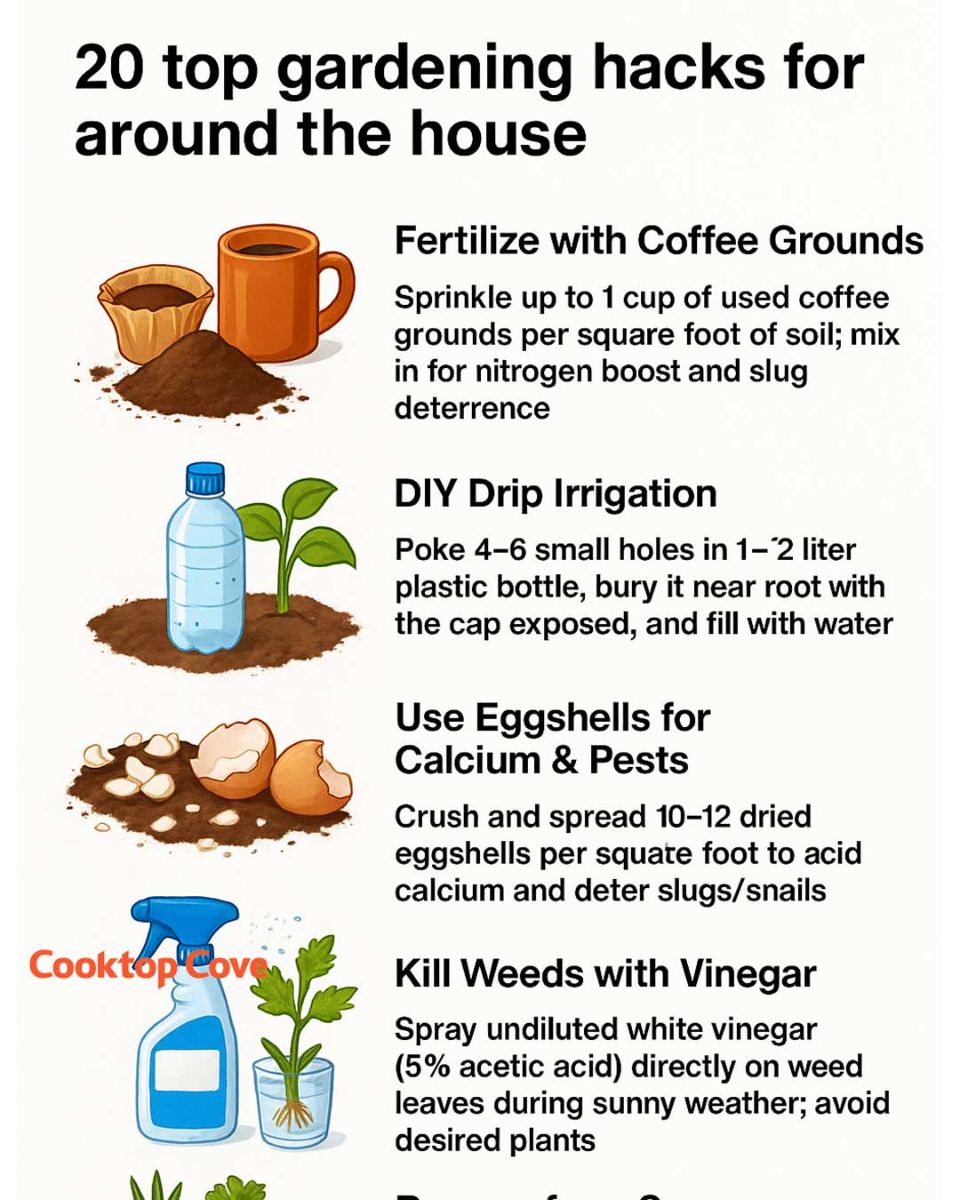ADVERTISEMENT
3. Repurpose Eggshells for Plant Health
Eggshells are rich in calcium, which is vital for plant health. To use eggshells in your garden, rinse them thoroughly and allow them to dry. Crush the shells into small pieces and sprinkle them around the base of your plants. This will help improve soil structure and provide a slow-release source of calcium.
Eggshells can also be used to deter pests like slugs and snails. The sharp edges of the crushed shells are uncomfortable for these pests to crawl over, making them an effective natural barrier. For best results, apply a generous layer of crushed eggshells around the perimeter of your garden beds.
4. Use Vinegar to Kill Weeds
Vinegar is a natural and effective weed killer that can help you maintain a tidy garden. To use vinegar for weed control, fill a spray bottle with white vinegar and apply it directly to the leaves of the weeds. The acetic acid in the vinegar will dry out the leaves, killing the weeds within a few days.
For best results, apply vinegar on a sunny day, as the heat will enhance its effectiveness. Be careful not to spray vinegar on your desirable plants, as it can harm them as well. For stubborn weeds, you may need to reapply the vinegar several times.
5. Grow Plants from Kitchen Scraps
Many kitchen scraps can be regrown into new plants, providing a sustainable way to expand your garden. For example, you can regrow green onions by placing the white roots in a glass of water. Within a few days, new shoots will begin to grow, and you can plant them in soil once they reach a few inches in height.
Other vegetables that can be regrown from scraps include lettuce, celery, and potatoes. Simply place the base of a lettuce or celery stalk in water and wait for new growth to appear. For potatoes, cut them into pieces with at least one ‘eye’ each, and plant them in soil. With a little patience, you’ll have a fresh supply of produce right from your kitchen.
6. Make a Natural Pest Repellent with Garlic
Garlic is a powerful natural pest repellent that can help protect your plants from insects. To make a garlic spray, blend two bulbs of garlic with a quart of water, then strain the mixture to remove any solids. Add a tablespoon of dish soap to help the solution adhere to plant leaves.
Spray the garlic solution on your plants, focusing on the undersides of leaves where pests often hide. This natural repellent is effective against a variety of insects, including aphids, beetles, and caterpillars. Reapply the spray every few weeks or after heavy rain to maintain its effectiveness.
7. Use Baking Soda to Sweeten Tomatoes
Baking soda can help sweeten tomatoes by reducing the acidity of the soil. To use this hack, sprinkle a small amount of baking soda around the base of your tomato plants, being careful not to get any on the leaves. Use about one tablespoon per plant, and water the area thoroughly to help the baking soda dissolve into the soil.
This simple trick can enhance the flavor of your tomatoes, making them taste sweeter and more delicious. Just be sure to use baking soda sparingly, as too much can alter the soil’s pH balance and affect plant growth.
8. Create a Mini Greenhouse with Plastic Bottles
Plastic bottles can be repurposed into mini greenhouses to protect young plants from harsh weather and pests. To make a mini greenhouse, cut the bottom off a clear plastic bottle and place it over a seedling or small plant. The bottle will trap heat and moisture, creating a warm and humid environment that encourages growth.
This method is particularly useful in early spring when temperatures can still be unpredictable. As the weather warms up, remove the bottle during the day to prevent overheating, and replace it at night for continued protection.
9. Use Epsom Salt for Greener Plants
Epsom salt is a natural source of magnesium and sulfate, which are essential nutrients for plant health. To use Epsom salt in your garden, dissolve two tablespoons in a gallon of water and use it to water your plants once a month. This solution can help improve the color and vigor of your plants, making them greener and more robust.
Epsom salt is particularly beneficial for plants like tomatoes, peppers, and roses, which often suffer from magnesium deficiency. By providing these nutrients, you can enhance the overall health and productivity of your garden.
10. Start Seedlings in Citrus Peels
Citrus peels can be used as biodegradable seed starters, providing a nutrient-rich environment for seedlings. To use this hack, cut a citrus fruit in half and scoop out the flesh, leaving the peel intact. Fill the peel with potting soil and plant your seeds inside.
Once the seedlings are ready to be transplanted, you can plant the entire peel in the ground. The peel will decompose over time, adding nutrients to the soil and supporting the growth of your plants. This method is an eco-friendly way to start seeds and reduce waste.
11. Use Banana Peels to Boost Flowering
Banana peels are rich in potassium, which is essential for flowering and fruiting plants. To use banana peels in your garden, chop them into small pieces and bury them in the soil around your plants. As the peels decompose, they will release potassium and other nutrients, promoting healthy blooms.
Alternatively, you can make a banana peel tea by soaking the peels in water for a few days. Use the liquid to water your plants, providing them with a nutrient boost that encourages flowering. This simple hack is an effective way to support the growth and beauty of your garden.
ADVERTISEMENT
